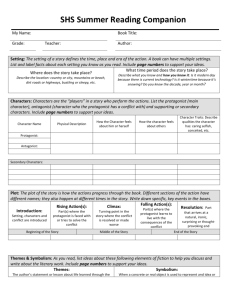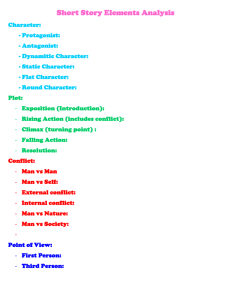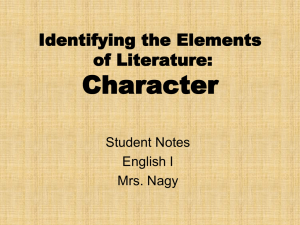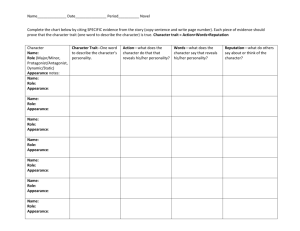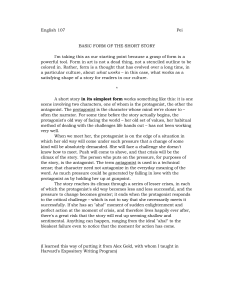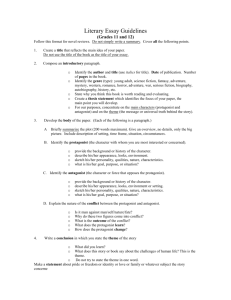Literary Terms #7 - AP English Literature and Composition
advertisement
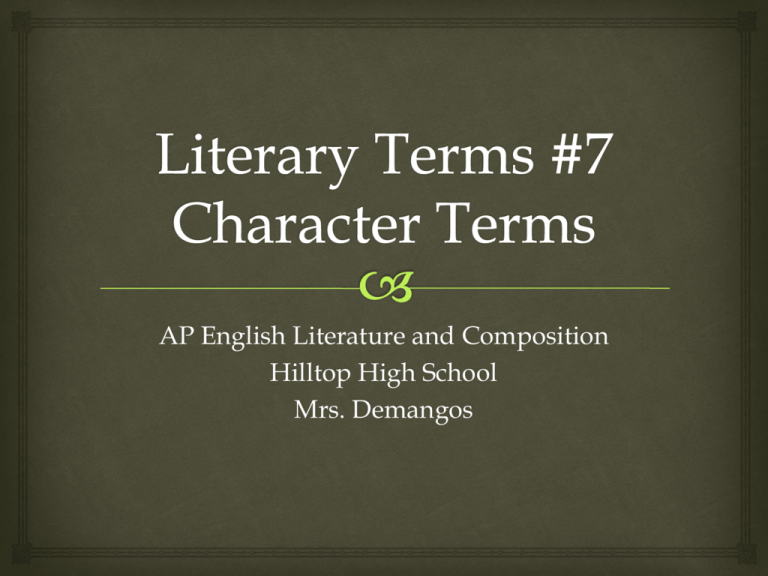
AP English Literature and Composition Hilltop High School Mrs. Demangos Round Character Complex, multi-faceted, not predictable A round character is depicted with such psychological depth and detail that he or she seems like a "real" person. The round character contrasts with the flat character, a character who serves a specific or minor literary function in a text, and who may be a stock character or simplified stereotype. Jean Valjean Round Character If the round character changes or evolves over the course of a narrative or appears to have the capacity for such change, the character is also dynamic. Typically, a short story has one round character and several flat ones. However, in longer novels and plays, there may be many round characters. The terms flat and round were first coined by the novelist E. M. Forster in his study, Aspects of the Novel. Flat Character Recognizable type; lacks complexity Also called a static character, a flat character is a simplified character who does not change or alter his or her personality over the course of a narrative, or one without extensive personality and characterization. The term is used in contrast with a round character. Scrooge Confidant Protagonist’s intimate Hamlet & Horatio Harry, Hermione & Ron Frodo & Sam Confidant The confidant is a person of great sensibility to whom the main character reveals his or her innermost thoughts . The confidant is essentially a listener and in some cases an adviser. This technique of having a confidant to whom the main character can talk serves a double function. First of all, it allows the reader to see what the main character is thinking, and secondly, it gives a more rounded view of the action. For example, after something has happened to the main character, the confidant hears about it and in their discussion of the event, we, the readers, see and understand the various subtle implications of this situation more clearly. Foil Character’s illuminator through contrast A character that serves by contrast to highlight or emphasize opposing traits in another character. In Shakespeare's Hamlet, Laertes the unthinking man of action is a foil to the intelligent but reluctant Hamlet. Foil The angry hothead Hotspur in Henry IV, Part I, is the foil to the cool and calculating Prince Hal. Protagonist Character around which the action is centered Antagonist Person or force working against the protagonist The term antagonist comes from Greek word “antagonistēs” that means opponent, competitor or rival. It is common to refer to an antagonist as a villain (the bad guy) against whom a hero (the good guy) fights in order to relieve himself or others. Generally, an antagonist appears as a foil to the main character embodying qualities that are in contrast with the qualities of the main character. Antagonist A classical example of an antagonist is that of King Creon in Sophocles’ tragedy “Antigone”. Here, the function of the antagonist is to obstruct the main character’s progress through evil plots and actions. Antigone, the protagonist, struggles against King Creon, the antagonist, in her effort to give her brother a respectable burial. Through his evil designs, Creon tries to hamper her in this attempt by announcing that her brother is a traitor and decreeing that “he must be left to the elements.” This protagonist-antagonist conflict becomes the theme of this tragedy. Omniscience Teller knows all about everyone The third-person narrator can be omniscient--a narrator who knows everything that needs to be known about the agents and events in the story, and is free to move at will in time and place, and who has privileged access to a character's thoughts, feelings, and motives. Omniscience Middlemarch by George Eliot Charlotte's Web by E.B. White Limited Omniscience Teller knows all about one character The narrator can also be limited--a narrator who is confined to what is experienced, thought, or felt by a single character, or at most a limited number of characters. Dramatic Perspective Teller presents just the facts When the narrator reports speech and action, but never comments on the thoughts of other characters, it is the dramatic third person point of view or objective point of view. Example: “The Lottery” by Shirley Jackson Doppelganger Mysterious double Doppelganger, German word meaning “look-alike” or “double walker”, originally meant a ghost or shadow of a person but nowadays it simply refers to a person that is a look-alike of another person. In literature, doppelganger is usually shaped as a twin, shadow or a mirror image of a protagonist. It refers to a character who physically resembles the protagonist and may have the same name as well. Several types of doppelganger can be spotted in world literature. It may take the form of an “evil twin”, not known to the actual person, who confuses people related to that original person. Besides, it may be figured as one person existing in two different places at the same time. Sometimes, a doppelganger is a person’s past or future self. In some cases, it may simply be a person’s look alike. Doppelganger “William Wilson”, a short story by Edgar Allan Poe follows the theme of doppelganger. William, the protagonist, meets another boy in school who had the same name and looked surprisingly like him. He dressed and even walked like him. The only difference between them was that the doppelganger of William could only talk in a whisper. The doppelganger haunts William all his life. Worn out by interference from his double in his affairs, William stabs him only to find in the mirror that he has stabbed himself: “In me didst thou exist—and, in my death, see by this image, which is thine own, how utterly thou hast murdered thyself.” Doppelganger Robert Louis Stevenson explores the theme of doppelganger in his novel “Dr. Jekyll and Mr. Hyde”. Hyde is an evil double of the honorable Dr. Jekyll. Jekyll creates Hyde by scientific experiments to prove his statement: “man is not truly one, but truly two.” He means that the human soul is a mixture of evil and good and Hyde is the manifestation of the evil that existed in Dr. Jekyll. As a respectable Victorian gentleman, Jekyll can never fulfill the evil desires existing in him. Therefore, he separates his “evil-self” by giving himself a separate identity. Doppelganger A survey of Doppelganger examples leads one to conclude that this literary device serves a variety of purposes in literature. It may be used to show the “other self” of a character that he or she has not discovered yet. This “other self” could be the darker side of the character that troubles or the brighter side that motivates. Hence, it helps writers to portray complex characters. Moreover, doppelganger gives rise to a conflict in a story. The doppelganger acts in a way that promises dire consequences for the main character that puts in efforts to undo the actions of his double. Sometimes, the conflict is an inner one where a character tries to understand himself by understanding his doppelganger. Antihero An ordinary, modern man/woman groping through life A protagonist who is a non-hero or the antithesis of a traditional hero. While the traditional hero may be dashing, strong, brave, resourceful, or handsome, the antihero may be incompetent, unlucky, clumsy, dumb, ugly, or clownish. Antihero Examples here might include the senile protagonist of Cervantes' Don Quixote or the girlish knight Sir Thopas from Chaucer's "Sir Thopas." Antihero In the case of the Byronic and The same is true of Heathcliffe in Emily Bronté's Wuthering Heights. Miltonic antihero, the antihero is a romanticized but wicked character who defies authority, and becomes paradoxically ennobled by his peculiar rejection of virtue. In this sense, Milton presents Satan in Paradise Lost as an antihero in a sympathetic manner--at least in the first half of the poem.


